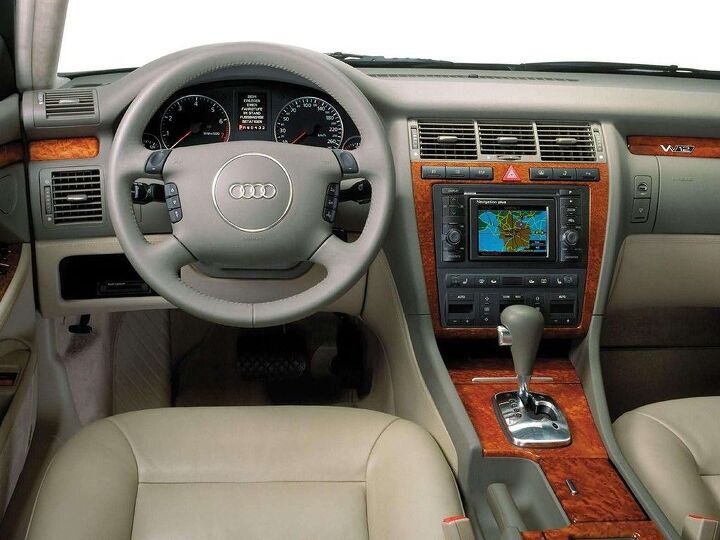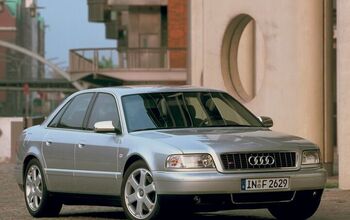Rare Rides: An Almost New Audi S8 From 2001 (Part I)

Rare Rides has featured the predecessor of today’s sedan previously, in a very pearly 1990 V8 Quattro. After Audi spent a few years unsuccessfully trying to sell its first-ever attempt at a flagship full-size sedan, it took the lessons learned from the D1 and developed the D2 A8 and S8.
Today we’ll focus primarily on the A8 foundations that made the S8 possible. Work on the D2 platform began in 1982 when Ferdinand Piech signed a development contract with Aluminum Company of America (you’d probably call it Alcoa). The goal of the agreement was the use of aluminum technology to design a sedan that was lighter than other cars of a similar size class.
The weight saving via lighter metals would make up for the heavy Quattro all-wheel-drive system, which was a given in any flagship Audi. Not eager to repeat the same platform sharing mistake as with the V8 Quattro, the D2 was not an evolution of the steel D1, but rather an entirely new aluminum monocoque platform. Audi dubbed it the ASF, or Audi Space Frame. The Space Frame’s logo was proudly displayed on the lower b-pillars of every A8.
The new A8 was presented at the 1994 Geneva Auto Show and went into production later that year. At the start Audi’s new offering wasn’t quite ready for North American duty: A8 did not arrive in the US until the 1997 model year, and when it did it was more limited in scope than other markets. North American bound A8s were all equipped with Quattro all-wheel drive and (for obvious reasons) a five-speed automatic transmission. While markets outside of North America were offered V6 engines of gasoline and diesel persuasion, all North American A8s were equipped with Audi’s 4.2-liter V8. All North American examples were standard-wheelbase through 1999, but the long-wheelbase arrived for 2000. The L offered five additional inches of rear legroom and meant the lineup was more competitive with offerings from BMW and Mercedes-Benz that came with length. An ultimate version with a 6.0-liter W12 engine was offered from 2001 and was very expensive.
We’ve got the foundations covered, so in Part II we’ll talk about Audi’s transformation of the A8 into a high-performance sports sedan. And I’ll show you the S8 for sale that’s hardly been used.
[Images: Audi]

Interested in lots of cars and their various historical contexts. Started writing articles for TTAC in late 2016, when my first posts were QOTDs. From there I started a few new series like Rare Rides, Buy/Drive/Burn, Abandoned History, and most recently Rare Rides Icons. Operating from a home base in Cincinnati, Ohio, a relative auto journalist dead zone. Many of my articles are prompted by something I'll see on social media that sparks my interest and causes me to research. Finding articles and information from the early days of the internet and beyond that covers the little details lost to time: trim packages, color and wheel choices, interior fabrics. Beyond those, I'm fascinated by automotive industry experiments, both failures and successes. Lately I've taken an interest in AI, and generating "what if" type images for car models long dead. Reincarnating a modern Toyota Paseo, Lincoln Mark IX, or Isuzu Trooper through a text prompt is fun. Fun to post them on Twitter too, and watch people overreact. To that end, the social media I use most is Twitter, @CoreyLewis86. I also contribute pieces for Forbes Wheels and Forbes Home.
More by Corey Lewis
Latest Car Reviews
Read moreLatest Product Reviews
Read moreRecent Comments
- Golden2husky Tuscadero? Wonder if the interior comes in Leather...
- Lou_BC I don't like black. I wouldn't want white because that's your standard fleet colour. I lean towards colour's that are less likely to show scratches and dings. The blue on my ZR2 is nice colour but a bad colour for showing up trail rash and dust. It wasn't my 1st choice but at the time it was the only truck I could find at a price I was willing to pay.
- Michael I don’t have the luxury of choosing the color of my car and even people in my life who have recently purchased relatively expensive new cars are having their choice of what local dealers have or what they’re getting in soon, shades of grey and white. If I had the choice I would have gone with color when I was younger but now would choose a silver, grey, or black. Whatever looked best on the model.
- CoastieLenn That price seems a bit high for a high mileage mid-tier Accord, especially a coupe whose resale is typically lower than the stalwart sedan. I do like this generation coupe a lot though.
- La3541 Red is my go-to color. I love candy-apple red (guards red on Porsche). I have had several red cars. Maroon is not good though.I have always loved British racing green and recently got my first one. A British racing green 4-series that I had to special-order.Silver, black, gray, and white are pretty boring. However, as RNA656.. stated, white looks good on some cars. for more boring colors, I also like chalk on porsches. Nardo gray on Audis is pretty nice.





































Comments
Join the conversation
A friend traded his A4 for his sister's A6 ( it was too big for her ) then, a year later, traded the A6 for his parent's neighbour's S8, which was too big for the wife's liking. A4 to S8 in a year - for free. I was with him when the driver's door suddenly decided to not latch anymore: a CDN$900 fix. The central HVAC tunnel would often fill with water, too, even with the windshield drains absolutely clear. Seeing the engine that far forward in the engine bay was always off-putting for me. Otherwise a great car, if you can afford the upkeep.
I loved these when they were current. Having owned a 2002 S4, however, has all but ruined Audi's for me, this one included. Were they as unreliable as the B5s of the day?